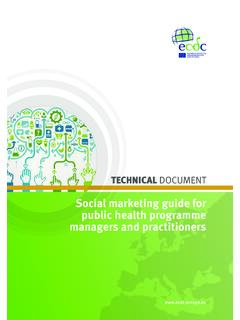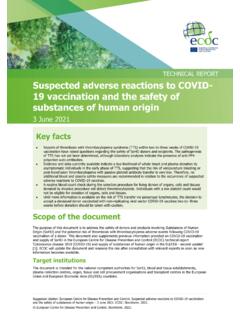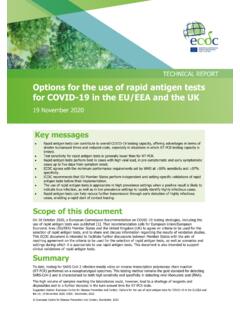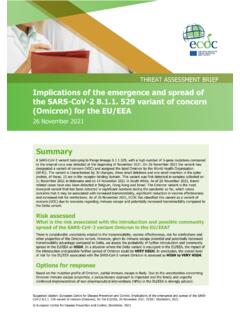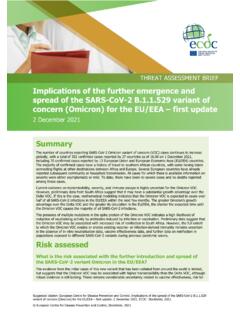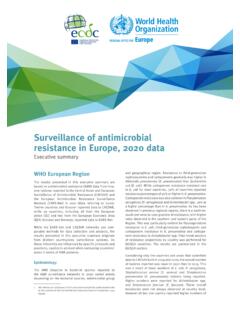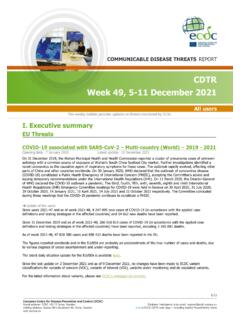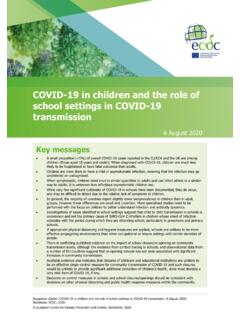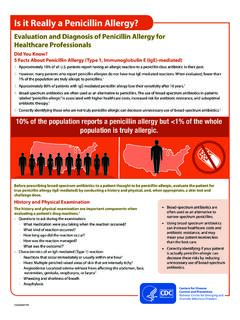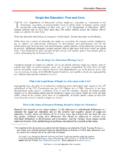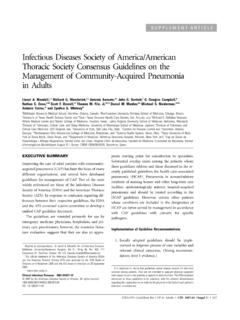Transcription of SURVEILLANCE REPORT: Antimicrobial resistance …
1 SURVEILLANCE report . Antimicrobial resistance SURVEILLANCE in europe 2014. Antimicrobial resistance SURVEILLANCE in europe Annual report of the European Antimicrobial resistance SURVEILLANCE Network (EARS-Net). 2014. Antimicrobial resistance SURVEILLANCE in europe 2014 SURVEILLANCE report . The European Centre for Disease Prevention and Control (ECDC) wishes to thank all EARS-Net participating laboratories and hospitals in the Member States for providing data for this report . Furthermore, all EARS-Net Operational Contact Points and National Focal Points are acknowledged for facilitating data transfer and providing valuable comments for this report . ECDC staff members Catalin Albu and Encarna Jimenez, and WHONET representative John Stelling are acknowledged for data management and providing technical support to the participating countries. ECDC staff members Liselotte Diaz H gberg and Ole Heuer are acknowledged for the preparation of the report , and Christine Walton at UK NEQAS is acknowledged for her contribution to Annex 1.
2 In addition, ECDC wishes to thank EARS-Net Coordination group members Derek Brown, Jose Campos, Tim Eckmanns, Christian Giske, Hajo Grundmann, Vincent Jarlier, Alan Johnson, Gunnar Kahlmeter, Jos Monen, Annalisa Pantosti, Gian Maria Rossolini, Gunnar Skov Simonsen, Nienke van de Sande-Bruinsma, Alkiviadis Vatopoulos, Dorota abicka and Helena emli kov for providing scientific advice during the production of the report and contributing to the sections covering the clinical and epidemiological importance and resistance mechanisms. Suggested citation for full report : European Centre for Disease Prevention and Control. Antimicrobial resistance SURVEILLANCE in europe 2014. Annual report of the European Antimicrobial resistance SURVEILLANCE Network (EARS-Net). Stockholm: ECDC; 2015. Cover picture istockphoto Stockholm, November 2015. ISSN 2363-2666. ISBN 978-92-9193-729-5. doi Catalogue number TQ-AM-15-001-EN-N. European Centre for Disease Prevention and Control, 2015. Reproduction is authorised, provided the source is acknowledged.
3 Ii SURVEILLANCE report Antimicrobial resistance SURVEILLANCE in europe 2014. Contents Abbreviations and acronyms .. vii National institutions/organisations participating in EARS-Net .. viii Summary .. 1. 1 Introduction .. 3. Antimicrobial resistance .. 3. EARS-Net .. 3. Harmonisation of European breakpoints and methods through EUCAST .. 4. 2 EARS-Net data collection and analysis .. 6. Data analysis .. 6. Interpretation of the results .. 6. 3 Antimicrobial resistance in europe .. 8. Escherichia coli .. 8. Klebsiella pneumoniae .. 22. Pseudomonas aeruginosa .. 34. Acinetobacter species .. 47. Streptococcus pneumoniae .. 55. Staphylococcus aureus .. 62. Enterococci .. 65. References .. 70. Annexes .. 71. Annex 1. External quality assessment 2014 .. 73. Annex 2. EARS-Net laboratory/hospital denominator data 2014 .. 81. Country summary sheets .. 85. iii Antimicrobial resistance SURVEILLANCE in europe 2014 SURVEILLANCE report . List of tables Escherichia coli. Number of reporting laboratories reporting isolates resistant to third-generation cephalosporins (3 GCREC), numbers of 3 GCREC isolates and percentage of isolates positive for extended-spectrum beta-lactamase (ESBL), as ascertained by the participating laboratories, EU/EEA countries, 2014.
4 11. Escherichia coli. Total number of invasive isolates tested (N) and percentage with resistance to aminopenicillins (%R), including 95 % confidence intervals (95 % CI), EU/EEA countries, 2011-2014 .. 15. Escherichia coli. Total number of invasive isolates tested (N) and percentage with resistance to fluoroquinolones (%R), including 95 % confidence intervals (95 % CI), EU/EEA countries, 2011-2014 .. 16. Escherichia coli. Total number of invasive isolates tested (N) and percentage with resistance to third-generation cephalosporins (%R), including 95 % confidence intervals (95 % CI), EU/EEA countries, 2011-2014 .. 17. Escherichia coli. Total number of invasive isolates tested (N) and percentage with resistance to aminoglycosides (%R), including 95 % confidence intervals (95 % CI), EU/EEA countries, 2011-2014 .. 18. Escherichia coli. Total number of invasive isolates tested (N) and percentage with resistance to carbapenems (%R), including 95 % confidence intervals (95 % CI), EU/EEA countries, 2011-2014.
5 19. Escherichia coli. Total number of isolates tested (N) and percentage with combined resistance to fluoroquinolones, third-generation cephalosporins and aminoglycosides (%R), including 95 % confidence intervals (95 % CI), EU/EEA countries, 2011-2014 .. 20. Escherichia coli. Total number of tested isolates* and resistance combinations among invasive isolates tested against aminopenicillins, third-generation cephalosporins, fluoroquinolones, aminoglycosides and carbapenems (n=52 788), EU/EEA countries, 2014 .. 21. Klebsiella pneumoniae. Number of reporting laboratories reporting isolates resistant to third-generation cephalosporins (3 GCRKP), numbers of 3 GCRKP isolates and percentage of isolates positive for extended-spectrum beta-lactamase (ESBL), as ascertained by the participating laboratories, EU/EEA countries, 2014 .. 23. Klebsiella pneumoniae. Total number of invasive isolates tested (N) and percentage with resistance to fluoroquinolones (%R), including 95 % confidence intervals (95 % CI), EU/EEA countries, 2011-2014.
6 28. Klebsiella pneumoniae. Total number of invasive isolates tested (N) and percentage with resistance to third-generation cephalosporins (%R), including 95 % confidence intervals (95 % CI), EU/EEA countries, 2011-2014 .. 29. Klebsiella pneumoniae. Total number of invasive isolates tested (N) and percentage with resistance to aminoglycosides (%R), including 95 % confidence intervals (95 % CI), EU/EEA countries, 2011-2014 .. 30. Klebsiella pneumoniae. Total number of invasive isolates tested (N) and percentage with resistance to carbapenems (%R), including 95 % confidence intervals (95 % CI), EU/EEA countries, 2011-2014 .. 31. Klebsiella pneumoniae. Total number of isolates tested (N) and percentage with combined resistance to fluoroquinolones, third-generation cephalosporins and aminoglycosides (%R), including 95 % confidence intervals (95 % CI), EU/EEA countries, 2011-2014 .. 32. Klebsiella pneumoniae. Total number of tested invasive isolates* and resistance combinations against third-generation cephalosporins, fluoroquinolones, aminoglycosides and carbapenems (n=18 180), EU/EEA countries, 2014.
7 33. Pseudomonas aeruginosa. Total number of invasive isolates tested (N) and percentage with resistance to piperacillin + tazobactam (%R), including 95 % confidence intervals (95 %CI), EU/EEA countries, 2011-2014 .. 40. Pseudomonas aeruginosa. Total number of invasive isolates tested (N) and percentage with resistance to fluoroquinolones (%R), including 95 % confidence intervals (95 % CI), EU/EEA countries, 2011-2014 .. 41. Pseudomonas aeruginosa. Total number of invasive isolates tested (N) and percentage with resistance to ceftazidime (% R), including 95 % confidence intervals (95 % CI), EU/EEA countries, 2011-2014 .. 42. Pseudomonas aeruginosa. Total number of invasive isolates tested (N) and percentage with resistance to aminoglycosides (%R), including 95 % confidence intervals (95 % CI), EU/EEA countries, 2011-2014 .. 43. Pseudomonas aeruginosa. Total number of invasive isolates tested (N) and percentage with resistance to carbapenems (%R), including 95 % confidence intervals (95 % CI), EU/EEA countries, 2011-2014.
8 44. Pseudomonas aeruginosa. Total number of invasive isolates tested (N) with combined resistance ( resistance to three or more Antimicrobial groups among piperacillin + tazobactam, ceftazidime, fluoroquinolones, aminoglycosides and carbapenems). including 95 % confidence intervals (95 % CI), by country, EU/EEA countries, 2011-2014 .. 45. Pseudomonas aeruginosa. Total number of tested isolates and resistance combinations among invasive isolates tested against at least three Antimicrobial groups among piperacillin + tazobactam, ceftazidime, fluoroquinolones, aminoglycosides and carbapenems (n = 11 649), EU/EEA countries, 2014 .. 46. Acinetobacter spp. Total number of invasive isolates tested (N) and percentage with resistance to fluoroquinolones (%R), including 95 % confidence intervals (95 % CI), EU/EEA countries, 2012-2014 .. 51. Acinetobacter spp. Total number of invasive isolates tested (N) and percentage with resistance to aminoglycosides (%R), including 95 % confidence intervals (95 % CI), EU/EEA countries, 2012-2014.
9 52. Acinetobacter spp. Total number of invasive isolates tested (N) and percentage with resistance to carbapenems (%R), including 95 % confidence intervals (95 % CI), EU/EEA countries, 2012-2014 .. 53. Acinetobacter spp. Total number of isolates tested (N) and percentage with combined resistance to fluoroquinolones, aminoglycosides and carbapenems (%R), including 95 % confidence intervals (95 % CI), by country, EU/EEA countries, 2012-2014 .. 54. Acinetobacter spp. Overall resistance and resistance combinations among invasive isolates tested to fluoroquinolones, aminoglycosides and carbapenems (n = 3 910), EU and EEA countries, 2014 .. 54. Streptococcus pneumoniae. Total number of tested isolates (N) and percentages non-susceptible to penicillin (%IR), including 95 % confidence intervals (95 % CI), by country, EU/EEA countries, 2011-2014 .. 59. iv SURVEILLANCE report Antimicrobial resistance SURVEILLANCE in europe 2014. Streptococcus pneumoniae. Total number of tested isolates (N) and percentages non-susceptible to macrolides (%IR), including 95 % confidence intervals (95 % CI), by country, EU/EEA countries, 2011-2014.
10 60. Streptococcus pneumoniae. Total number of tested isolates (N) and percentages non-susceptible to penicillins and macrolides (%IR), including 95 % confidence intervals (95 % CI), by country, EU/EEA countries, 2011-2014 .. 61. Staphylococcus aureus. Total number of invasive isolates tested (N) and percentage with resistance to meticillin (MRSA) including 95 % confidence intervals (95 % CI), EU/EEA countries, 2011-2014 .. 64. Enterococcus faecalis. Total number of invasive isolates tested (N) and percentage with high-level resistance to aminoglycosides including 95 % confidence intervals (95 % CI), EU/EEA countries, 2011-2014 .. 68. Enterococcus faecium. Total number of invasive isolates tested (N) and percentage with resistance to vancomycin, including 95 % confidence intervals (95 % CI), EU/EEA countries, 2011-2014 .. 69. Escherichia coli (2 486). Minimum inhibitory concentration (MIC) and intended results reported by the reference laboratories (Ref 1 and Ref 2) and the overall concordance of the participating laboratories.
